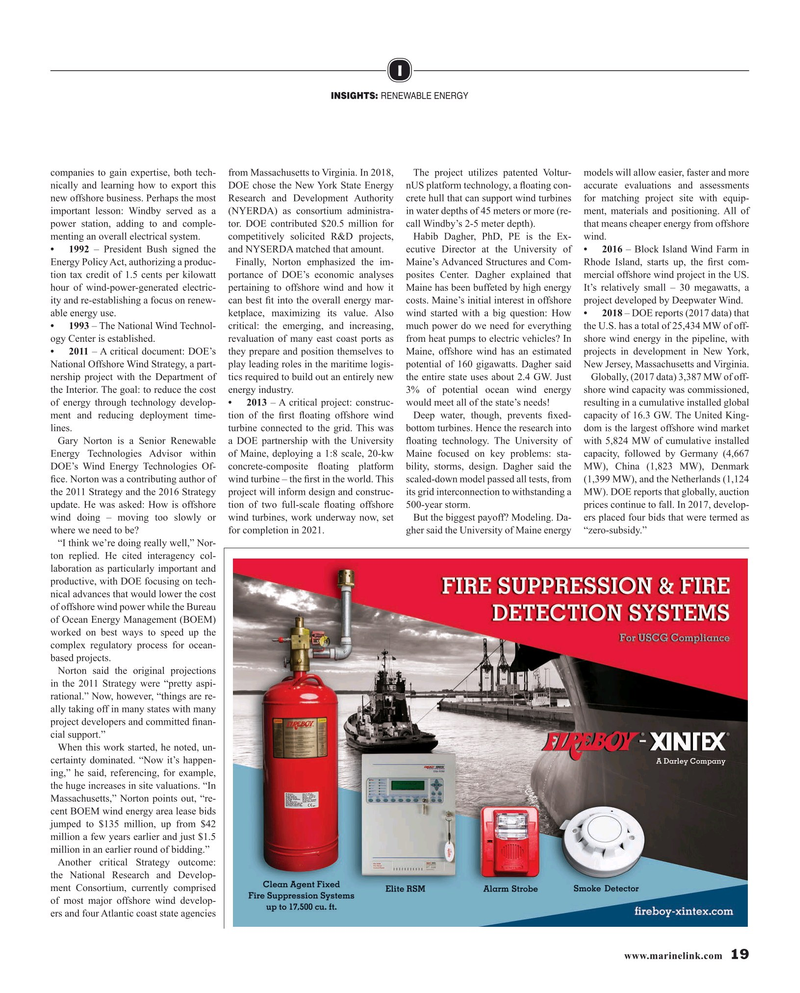
Page 19: of Maritime Reporter Magazine (June 2019)
80th Anniversary World Yearbook
Read this page in Pdf, Flash or Html5 edition of June 2019 Maritime Reporter Magazine
I
INSIGHTS: RENEWABLE ENERGY companies to gain expertise, both tech- from Massachusetts to Virginia. In 2018, The project utilizes patented Voltur- models will allow easier, faster and more nically and learning how to export this DOE chose the New York State Energy nUS platform technology, a ? oating con- accurate evaluations and assessments new offshore business. Perhaps the most Research and Development Authority crete hull that can support wind turbines for matching project site with equip- important lesson: Windby served as a (NYERDA) as consortium administra- in water depths of 45 meters or more (re- ment, materials and positioning. All of power station, adding to and comple- tor. DOE contributed $20.5 million for call Windby’s 2-5 meter depth). that means cheaper energy from offshore menting an overall electrical system. competitively solicited R&D projects, Habib Dagher, PhD, PE is the Ex- wind.
• 1992 – President Bush signed the and NYSERDA matched that amount. ecutive Director at the University of • 2016 – Block Island Wind Farm in
Energy Policy Act, authorizing a produc- Finally, Norton emphasized the im- Maine’s Advanced Structures and Com- Rhode Island, starts up, the ? rst com- tion tax credit of 1.5 cents per kilowatt portance of DOE’s economic analyses posites Center. Dagher explained that mercial offshore wind project in the US. hour of wind-power-generated electric- pertaining to offshore wind and how it Maine has been buffeted by high energy It’s relatively small – 30 megawatts, a ity and re-establishing a focus on renew- can best ? t into the overall energy mar- costs. Maine’s initial interest in offshore project developed by Deepwater Wind.
able energy use. ketplace, maximizing its value. Also wind started with a big question: How • 2018 – DOE reports (2017 data) that • 1993 – The National Wind Technol- critical: the emerging, and increasing, much power do we need for everything the U.S. has a total of 25,434 MW of off- ogy Center is established. revaluation of many east coast ports as from heat pumps to electric vehicles? In shore wind energy in the pipeline, with • 2011 – A critical document: DOE’s they prepare and position themselves to Maine, offshore wind has an estimated projects in development in New York,
National Offshore Wind Strategy, a part- play leading roles in the maritime logis- potential of 160 gigawatts. Dagher said New Jersey, Massachusetts and Virginia. nership project with the Department of tics required to build out an entirely new the entire state uses about 2.4 GW. Just Globally, (2017 data) 3,387 MW of off- the Interior. The goal: to reduce the cost energy industry. 3% of potential ocean wind energy shore wind capacity was commissioned, of energy through technology develop- • 2013 – A critical project: construc- would meet all of the state’s needs! resulting in a cumulative installed global ment and reducing deployment time- tion of the ? rst ? oating offshore wind Deep water, though, prevents ? xed- capacity of 16.3 GW. The United King- lines. turbine connected to the grid. This was bottom turbines. Hence the research into dom is the largest offshore wind market
Gary Norton is a Senior Renewable a DOE partnership with the University ? oating technology. The University of with 5,824 MW of cumulative installed
Energy Technologies Advisor within of Maine, deploying a 1:8 scale, 20-kw Maine focused on key problems: sta- capacity, followed by Germany (4,667
DOE’s Wind Energy Technologies Of- concrete-composite ? oating platform bility, storms, design. Dagher said the MW), China (1,823 MW), Denmark ? ce. Norton was a contributing author of wind turbine – the ? rst in the world. This scaled-down model passed all tests, from (1,399 MW), and the Netherlands (1,124 the 2011 Strategy and the 2016 Strategy project will inform design and construc- its grid interconnection to withstanding a MW). DOE reports that globally, auction update. He was asked: How is offshore tion of two full-scale ? oating offshore 500-year storm. prices continue to fall. In 2017, develop- wind doing – moving too slowly or wind turbines, work underway now, set But the biggest payoff? Modeling. Da- ers placed four bids that were termed as where we need to be? for completion in 2021. gher said the University of Maine energy “zero-subsidy.” “I think we’re doing really well,” Nor- ton replied. He cited interagency col- laboration as particularly important and productive, with DOE focusing on tech- nical advances that would lower the cost of offshore wind power while the Bureau of Ocean Energy Management (BOEM) worked on best ways to speed up the complex regulatory process for ocean- based projects.
Norton said the original projections in the 2011 Strategy were “pretty aspi- rational.” Now, however, “things are re- ally taking off in many states with many project developers and committed ? nan- cial support.”
When this work started, he noted, un- certainty dominated. “Now it’s happen- ing,” he said, referencing, for example, the huge increases in site valuations. “In
Massachusetts,” Norton points out, “re- cent BOEM wind energy area lease bids jumped to $135 million, up from $42 million a few years earlier and just $1.5 million in an earlier round of bidding.”
Another critical Strategy outcome: the National Research and Develop- ment Consortium, currently comprised of most major offshore wind develop- ers and four Atlantic coast state agencies www.marinelink.com 19
MR #6 (18-25).indd 19 6/3/2019 11:23:42 AM

 18
18

 20
20
